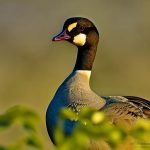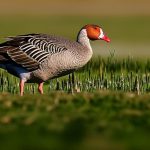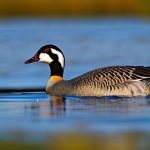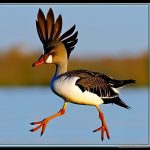Geese invading properties and causing damage is a common problem that many property owners face. These birds can be a nuisance, leaving behind droppings, damaging lawns, and even posing a threat to human safety. Fortunately, there are several methods that can be used to deter geese and prevent them from causing further damage.
One of the most effective ways to deter geese is by understanding their behavior and implementing strategies that target their habits and patterns. By creating physical barriers, implementing scare tactics, using decoys, removing food sources, planting vegetation, installing reflective surfaces, and using sound deterrents, property owners can effectively discourage geese from invading their properties.
Key Takeaways
- Geese are social animals and will return to areas where they feel safe and comfortable.
- Physical barriers such as fences or netting can prevent geese from accessing certain areas.
- Scare tactics such as loud noises or motion-activated devices can startle geese and discourage them from staying.
- Decoys that resemble predators or other geese can trick geese into thinking the area is unsafe.
- Removing food sources such as grass or seeds can make an area less attractive to geese.
- Planting tall vegetation can create a natural barrier and make an area less accessible to geese.
- Reflective surfaces such as mirrors or shiny objects can disorient geese and make them uncomfortable.
- Sound deterrents such as ultrasonic devices or predator calls can discourage geese from staying in an area.
- Enlisting the help of a professional can provide more effective and humane solutions for managing geese.
- Consistency is key in maintaining a successful strategy for managing geese.
Understanding the behavior of geese
To effectively deter geese, it is important to understand why they are attracted to certain areas and what their habits and patterns are. Geese are attracted to areas that provide them with food, water, and shelter. They are also social animals and tend to gather in large groups.
Geese have a strong homing instinct and will return to the same areas year after year. They are also creatures of habit and tend to follow the same flight paths and feeding patterns. By understanding these behaviors, property owners can implement strategies that disrupt these patterns and make their properties less attractive to geese.
Creating physical barriers
One of the most effective ways to deter geese is by creating physical barriers that prevent them from accessing certain areas. There are several types of physical barriers that can be used, including fences, netting, and hedges.
Fences can be used to create a physical barrier between geese and the desired area. They should be at least three feet high and have small openings to prevent geese from squeezing through. Netting can be used to cover ponds or other bodies of water to prevent geese from landing or swimming in them. Hedges can be planted around the perimeter of the property to create a natural barrier that geese are less likely to cross.
It is important to properly install and maintain physical barriers to ensure their effectiveness. Fences should be securely anchored to the ground and checked regularly for any damage or gaps. Netting should be properly secured and checked for any tears or holes. Hedges should be pruned regularly to maintain their density and height.
Implementing scare tactics
Scare tactics can be an effective way to deter geese from invading properties. There are several scare tactics that can be used, including visual deterrents, noise deterrents, and motion deterrents.
Visual deterrents can include things like scarecrows, balloons, or flags that move in the wind. These visual stimuli can startle geese and make them feel unsafe, causing them to avoid the area. Noise deterrents can include things like loud noises or predator calls that mimic the sounds of natural predators. Motion deterrents can include things like sprinklers or wind chimes that create movement and noise.
It is important to properly use scare tactics without harming the geese. Scare tactics should be used consistently and in combination with other methods to maximize their effectiveness. It is also important to regularly change the location or type of scare tactic used to prevent geese from becoming accustomed to them.
Using decoys
Decoys can be an effective way to deter geese by creating the illusion of a predator or other threat. There are several types of decoys that can be used, including predator decoys, swan decoys, and coyote decoys.
Predator decoys can include things like fake owls or hawks that resemble natural predators of geese. Swan decoys can be used to create the illusion of a territorial swan that geese will avoid. Coyote decoys can be used to create the illusion of a predator on land that geese will avoid.
It is important to properly use decoys to deter geese. Decoys should be placed in areas where geese are likely to gather, such as near bodies of water or feeding areas. They should be moved regularly to prevent geese from becoming accustomed to them.
Removing food sources

Removing food sources is an important step in deterring geese from invading properties. Geese are attracted to areas that provide them with a reliable source of food, such as grass, grains, or berries.
To remove food sources, property owners can regularly mow their lawns to keep the grass short and less attractive to geese. They can also remove any fallen fruits or berries from trees or bushes. It is important to properly remove food sources without harming the geese. Property owners should avoid using harmful chemicals or pesticides that could harm the geese or other wildlife.
Planting vegetation
Planting vegetation can be an effective way to deter geese by making certain areas less attractive to them. There are several types of vegetation that can be planted, including tall grasses, shrubs, and trees.
Tall grasses can create a physical barrier that geese are less likely to cross. Shrubs and trees can provide shelter and nesting sites for geese, making them less likely to invade other areas. It is important to properly plant and maintain vegetation to deter geese. Tall grasses should be planted in dense clusters and regularly trimmed to maintain their height. Shrubs and trees should be pruned regularly to prevent them from becoming too dense or overgrown.
Installing reflective surfaces
Reflective surfaces can be an effective way to deter geese by creating visual stimuli that make them feel unsafe. There are several types of reflective surfaces that can be used, including mirrors, shiny objects, and reflective tape.
Mirrors can be strategically placed around the property to create the illusion of a larger space or to reflect light in a way that is unsettling to geese. Shiny objects, such as aluminum foil or CDs, can be hung from trees or fences to create movement and reflection. Reflective tape can be tied to stakes and placed around the perimeter of the property to create a visual barrier that geese are less likely to cross.
It is important to properly install and maintain reflective surfaces to ensure their effectiveness. Mirrors should be securely anchored and regularly cleaned to maintain their reflective properties. Shiny objects and reflective tape should be regularly checked for any damage or fading.
Using sound deterrents
Sound deterrents can be an effective way to deter geese by creating noise that makes them feel unsafe. There are several types of sound deterrents that can be used, including ultrasonic devices, noise machines, and bird distress calls.
Ultrasonic devices emit high-frequency sounds that are unpleasant to geese but not audible to humans. Noise machines can be programmed to emit loud noises at regular intervals or in response to motion. Bird distress calls can mimic the sounds of injured or distressed birds, causing geese to avoid the area.
It is important to properly use sound deterrents without harming the geese. Sound deterrents should be used consistently and in combination with other methods to maximize their effectiveness. It is also important to regularly change the type or location of sound deterrent used to prevent geese from becoming accustomed to them.
Enlisting the help of a professional
In some cases, it may be necessary to enlist the help of a professional to effectively deter geese from invading properties. A professional can provide expert advice and assistance in implementing strategies that are tailored to the specific needs of the property.
When choosing a professional, it is important to properly research and vet potential candidates. Property owners should look for professionals who have experience in deterring geese and who use humane and environmentally friendly methods. It is also important to clearly communicate expectations and goals to ensure that the professional understands the desired outcome.
Maintaining a consistent strategy
To effectively deter geese, it is important to maintain a consistent strategy and regularly evaluate and adjust as needed. Geese are intelligent animals and can quickly adapt to new deterrents or overcome obstacles.
Property owners should regularly evaluate the effectiveness of their chosen methods and make adjustments as needed. This may include changing the location or type of deterrent used, or implementing additional strategies to reinforce existing ones. It is important to be patient and persistent, as deterring geese may require ongoing effort and vigilance.
In conclusion, geese invading properties and causing damage can be a frustrating problem for property owners. However, by understanding the behavior of geese and implementing effective strategies, it is possible to deter geese and prevent further damage.
Creating physical barriers, implementing scare tactics, using decoys, removing food sources, planting vegetation, installing reflective surfaces, using sound deterrents, enlisting the help of a professional, and maintaining a consistent strategy are all effective methods that can be used to deter geese.
By taking action and implementing these strategies, property owners can reclaim their properties from geese and create a safe and enjoyable environment for themselves and their families.
If you’re looking for effective ways to keep geese off your shoreline, you might also be interested in learning about how to protect your quail eggs. Poultry Wizard has a helpful article on whether quails sit on their eggs, providing insights and tips for successful breeding. Understanding the behavior of these birds can be beneficial in implementing strategies to deter geese from your property. Check out the article here to gain valuable knowledge on quail egg protection and enhance your geese control efforts.
FAQs
What are the common problems caused by geese on shorelines?
Geese can cause damage to the shoreline vegetation, create unsanitary conditions, and pose a threat to human safety.
What are some effective ways to keep geese off your shoreline?
Some effective ways to keep geese off your shoreline include using decoys, installing fencing or netting, using noise deterrents, and planting vegetation that geese do not like.
What are some natural ways to deter geese from your shoreline?
Some natural ways to deter geese from your shoreline include planting tall grasses, using natural predators like dogs or hawks, and creating a natural barrier with rocks or logs.
Is it legal to harm or kill geese to keep them off your shoreline?
No, it is not legal to harm or kill geese to keep them off your shoreline. Geese are protected under federal law, and there are strict regulations in place for their management.
What should I do if I encounter an injured or sick goose on my shoreline?
If you encounter an injured or sick goose on your shoreline, it is best to contact a local wildlife rehabilitation center or animal control agency for assistance. Do not attempt to handle the goose yourself, as they can be aggressive and may cause injury.
Meet Walter, the feathered-friend fanatic of Florida! Nestled in the sunshine state, Walter struts through life with his feathered companions, clucking his way to happiness. With a coop that’s fancier than a five-star hotel, he’s the Don Juan of the chicken world. When he’s not teaching his hens to do the cha-cha, you’ll find him in a heated debate with his prized rooster, Sir Clucks-a-Lot. Walter’s poultry passion is no yolk; he’s the sunny-side-up guy you never knew you needed in your flock of friends!







